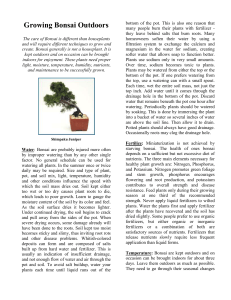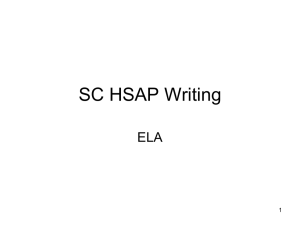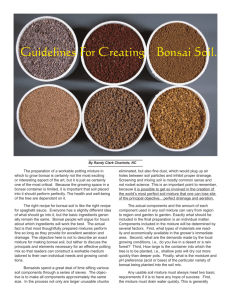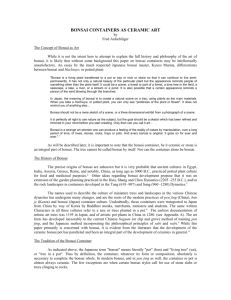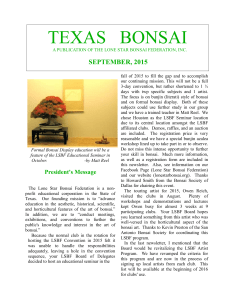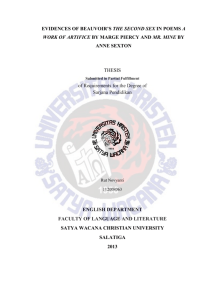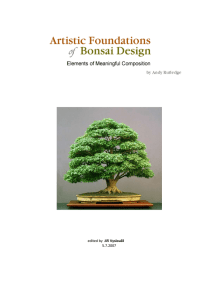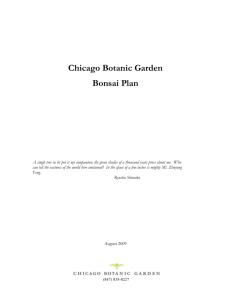Growing Bonsai indoors
advertisement
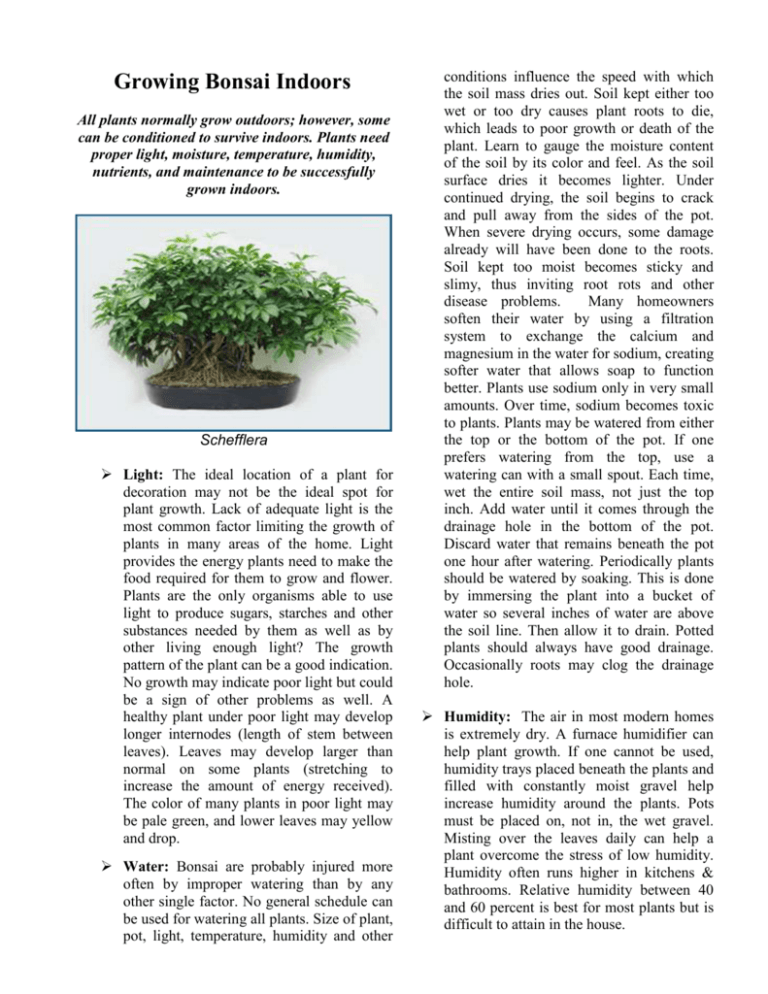
Growing Bonsai Indoors All plants normally grow outdoors; however, some can be conditioned to survive indoors. Plants need proper light, moisture, temperature, humidity, nutrients, and maintenance to be successfully grown indoors. Schefflera Light: The ideal location of a plant for decoration may not be the ideal spot for plant growth. Lack of adequate light is the most common factor limiting the growth of plants in many areas of the home. Light provides the energy plants need to make the food required for them to grow and flower. Plants are the only organisms able to use light to produce sugars, starches and other substances needed by them as well as by other living enough light? The growth pattern of the plant can be a good indication. No growth may indicate poor light but could be a sign of other problems as well. A healthy plant under poor light may develop longer internodes (length of stem between leaves). Leaves may develop larger than normal on some plants (stretching to increase the amount of energy received). The color of many plants in poor light may be pale green, and lower leaves may yellow and drop. Water: Bonsai are probably injured more often by improper watering than by any other single factor. No general schedule can be used for watering all plants. Size of plant, pot, light, temperature, humidity and other conditions influence the speed with which the soil mass dries out. Soil kept either too wet or too dry causes plant roots to die, which leads to poor growth or death of the plant. Learn to gauge the moisture content of the soil by its color and feel. As the soil surface dries it becomes lighter. Under continued drying, the soil begins to crack and pull away from the sides of the pot. When severe drying occurs, some damage already will have been done to the roots. Soil kept too moist becomes sticky and slimy, thus inviting root rots and other disease problems. Many homeowners soften their water by using a filtration system to exchange the calcium and magnesium in the water for sodium, creating softer water that allows soap to function better. Plants use sodium only in very small amounts. Over time, sodium becomes toxic to plants. Plants may be watered from either the top or the bottom of the pot. If one prefers watering from the top, use a watering can with a small spout. Each time, wet the entire soil mass, not just the top inch. Add water until it comes through the drainage hole in the bottom of the pot. Discard water that remains beneath the pot one hour after watering. Periodically plants should be watered by soaking. This is done by immersing the plant into a bucket of water so several inches of water are above the soil line. Then allow it to drain. Potted plants should always have good drainage. Occasionally roots may clog the drainage hole. Humidity: The air in most modern homes is extremely dry. A furnace humidifier can help plant growth. If one cannot be used, humidity trays placed beneath the plants and filled with constantly moist gravel help increase humidity around the plants. Pots must be placed on, not in, the wet gravel. Misting over the leaves daily can help a plant overcome the stress of low humidity. Humidity often runs higher in kitchens & bathrooms. Relative humidity between 40 and 60 percent is best for most plants but is difficult to attain in the house. Fertilize: Miniaturization is not achieved by starving bonsai. The health of ones bonsai depends on a sufficient but not excessive diet of nutrients. The three main elements necessary for healthy plant growth are: Nitrogen, Phosphorus, and Potassium. Nitrogen promotes green foliage and stem growth, phosphorus encourages flowering and root production, and potassium contributes to overall strength and disease resistance. Feed plants only during their growing season at one third of the recommended strength. Never apply liquid fertilizers to wilted plants. Water the plants first and apply fertilizer after the plants have recovered and the soil has dried slightly. Some people prefer to use organic fertilizers, but either organic or inorganic fertilizers or a combination of both will be satisfactory sources of nutrients. Fertilizers that release nutrients slowly require less frequent application than liquid forms. are actively growing. Late May or June is a good time in the Savannah area. Chinese Banyan Pests: Watch new plants carefully for development of insect or disease problems. If detected early, these problems often can be corrected easily before serious damage is done. If ignored or unseen, they may become difficult to control. The three most common pests are spider mites, scales and mealy bugs. Bonsai Beginnings Green World Port Wentworth/Savannah Georgia 31407 Phone: 912-965-1030 Email: BonsaiBeginnings@Bellsouth.net Warm house Bonsai: Workshop demonstration Pruning: Trim excessive and distractive new growth that interferes with the harmony of the bonsai’s style. Trimming encourages new growth and speeds the ramification of the branches. Any wire used to shape the bonsai is temporary and should be removed before it damages the tree. Repotting: When the tree becomes almost root bound or doesn’t drain properly it needs to be repotted. Most tropical plants prefer to be repotted when it is very warm and they Ficus, Schefflera, Buttonwood, Norfolk Island Pine, Texas Ebony, Brazilian Raintree, Fukien Tea, Jacaranda, Black Olive Nicodemia, Cuphea, Aralia, Bamboo, Jades Bonsai Beginner’s Study Group meets Third Sunday of each month
